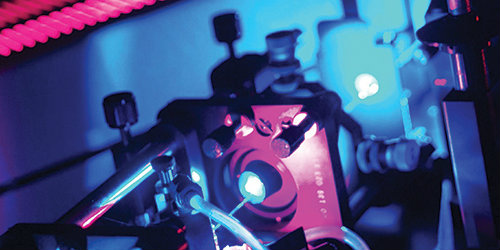World’s fastest atomic microscope revolutionises pace of innovation
Bristol led the development of the world’s first high speed atomic force microscope (HS-AFM) capable of producing tens of frames every second at an unprecedented nano-scale, in real time.
Advances in everything from cell biology to materials science are largely determined by the speed and efficiency of experimentation. For nearly 30 years, atomic force microscopy proved an invaluable instrument for scientists, engineers and industry. Now the imagination and ambition of University of Bristol researchers are realising its full potential.
On average, commercial atomic force microscopes can produce one image around every five minutes. In 2003, Dr Loren Picco and Dr Oliver Payton in Bristol’s School of Physics began exploring the possibilities of increasing both the resolution of the images delivered and the rate at which they are produced.
Small beginnings, great outcomes
Their primary motivation was to develop an instrument that could provide the deepest insights for any researchers or industry teams working on a material that lent itself to being imaged in a liquid or gaseous environment.
By 2009 they had developed the world’s first high speed atomic force microscope (HS-AFM) capable of producing tens of frames every second at an unprecedented nano-scale, in real time.
Once all these individual frames are stitched together the composite image is typically hundreds of megapixels or gigapixels in size – with each pixel representing an area of only four nanometres squared and one nanometre is a billionth of a metre. The HS-AFM is therefore creating and handling quantities of data that were previously inconceivably vast, and beyond the capabilities of ordinary AFMs.
Precision measurements
Dr Payton, a Royal Academy of Engineering Research Fellow, compares the mechanism of the HS-AFM to a record player – the cantilever works like a sharp tip at the end of a needle which feels its way over individual molecules.
The atomically sharp tip of the HS-AFM cantilever surfs the thin layers of water that are omnipresent in the environment. These layers of water act as a lubricant, preventing the tip or the sample surface from being worn away or damaged by the imaging. In this way the HS-AFM measures height and other material properties of the sample.
In the past six years, the HS-AFM has attracted interest from businesses and universities in the United States, Japan and the Czech Republic, all interested in how HS-AFM might solve their biggest challenges.
“We came up with the technique, but it’s collaborating with other people who have amazing ideas that produces results,” says Dr Picco, a Royal Academy of Engineering Enterprise Fellow.
Solving industry challenges
Since 2012, Drs Picco and Payton have been helping researchers from the Virginia Commonwealth University (VCU) and the University of California (UCLA) to use the HS-AFM to pioneer the gene sequencing of minute volumes of DNA, even down to the single cell level.
Using HS-AFM enables biologists to sidestep the need for time-consuming sample amplification and negates the need for expensive fluorescent labelling, which is how cells are ordinarily analysed. HS-AFM is now an integral part of the VCU-UCLA project, enabling researchers to measure hundreds of thousands of DNA molecules with nanometre resolution in minutes not weeks.
HS-AFM has also been used in a collaboration between Bristol’s Interface Analysis Centre and the energy company EDF Energy to determine the lifetime of the steel components used in their Advanced Gas Reactors.
Samples were taken from a cross section of material that had seen 18,000+ hours of operation at high temperatures. Analysis revealed nanoscale carbon formations, helping EDF to identify the key indicators for material degradation for their diagnostic maintenance tests. This ultimately helps them to ensure longer safe operation for their reactors.
The next stage in the development of HS-AFM is to create a software package that would enable people to use the instrument independently and to add simultaneous material property measurements.
“There’s lots of information available at the nanoscale if you know how and where to look for it,” adds Picco.
Related research groups
Related publications
- Large area high-speed metrology SPM system
- High-speed atomic force microscopy in slow motion-understanding cantilever behaviour at high scan velocities
- Opportunities in high-speed atomic force microscopy
- Error mapping of high-speed AFM systems
- High-speed AFM of human chromosomes in liquid
- Breaking the speed limit with atomic force microscopy
 Study Physics
Study Physics
Contribute to cutting edge research at the very frontier of scientific knowledge.
